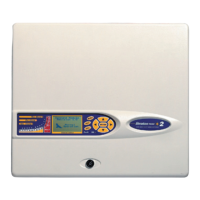Page 42
Stratos HSSD-2 • INSTALLER’S HANDBOOK • Iss. 12
When a Command Module is being used to manage one or more detectors (the
maximum limit is 127) then a Addressable Protocol Interface Card (APIC) may be used
to decode detector status information in the Command Module and relay to the the
Fire Panel via the Addressable Bus 1 and Bus 2 terminal block connections (see section
5.3.2 ‘Command Module terminal block connections’). In this configuration only one
interface is required and all detector information is available through this interface, one
address per device.
*It is not essential in networks of less than 127 detectors that a continuous unbroken
range of detector addresses is used, merely that all addresses are different and that
the full range of addresses is set on the APIC. However, any unused addresses would
then show up on the fire panel as in fault (detector not present). It is therefore recom-
mended that, when using a UAI to communicate to a fire panel, an unbroken range of
detector addresses is employed.
Note: some addressable
protocols may limit the
maximum number of
device addresses to less
than 127. The detector
address on the SenseNET
loop and the Fire Panel
addressable protocol
address are the same i.e.
no address translation is
performed. Some proto-
cols may not support all of
the available alarm levels
and fault reporting is usu-
ally a general fault with no
detailed fault information.
Detector 1
Start address: 1
End address: 127 *
Addressable
fire panel
Detector 127
Detector 2 Detector 126
8.3 Connecting a
Command Module
to an addressable
Fire Panel
Universal
addressable
interface
Command
Module Detector
Addressable loop

